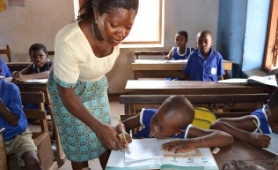 Poor health and nutrition prevent children from attending school and from learning to their best ability whilst there. School Health and Nutrition programmes (SHN) are amongst the most cost effective interventions that exist to improve both children’s education and health. They can add four to six points to IQ levels, 10% to school participation, and an additional one to two years of education (World Bank).
Poor health and nutrition prevent children from attending school and from learning to their best ability whilst there. School Health and Nutrition programmes (SHN) are amongst the most cost effective interventions that exist to improve both children’s education and health. They can add four to six points to IQ levels, 10% to school participation, and an additional one to two years of education (World Bank).
Globally, the number of children reaching school age is estimated to be 1.2 billion children, 18% of the world’s population, with 88% of these children living in less developed countries where there is a high prevalence of disease and illness.
The Impact of School Health and Nutrition (SHN) Programmes
SHN programmes, which have over the past two decades shifted significantly in focus from a medical approach to one which could reach the most disadvantaged and vulnerable, contribute to health outcomes and are a cost-effective intervention for improving school access and completion.
In 2000, in recognition of the impact of SHN programmes, development agencies
UNESCO,WHO,
UNICEF,
World Bank and
Partnership for Child Development launched the Focusing Resources on Effective School Health (FRESH) Framework in Dakar, Senegal as part of efforts to mainstream SHN in the education sector.
Selected SHN Interventions
School-based Deworming
Globally, millions of children are infected with parasitic helminths (or parasitic worms), with the greatest burden of parasitic disease being found in the poorest countries. Chronic worm infection can contribute to malnutrition, anaemia, stunting and wasting, which in turn can lead to long term retardation of mental and physical development.
School based deworming is universally recognized as a safe, simple and cost-effective solution with enduring benefits being seen immediately. Regular treatment at a cost of less than 50 US cents per child per year can reduce school absenteeism by 25%.
In 2010, malaria caused an estimated 655,000 deaths mostly among African children; in Africa a child dies every minute from malaria (WHO 2012).
Access to Safe Water, Sanitation and Hygiene
Lack of access to Safe Water, Sanitation and Hygiene services has grave repercussions for children, and along with the contamination of food this is the leading cause of diarrhoea among children which takes the lives of millions of children per year. Promoting messages in schools on regular handwashing with soap and clean water, particularly at critical times in the day, in addition to providing access to an adequate supply of clean, uncontaminated water and hygiene education and promotion is a simple and effective measure to prevent diarrhoea and child deaths from diarrhoea.
School Feeding
Stunting (low height for age) and underweight (low weight for age) are dangerously common in school-age children in low income countries and are frequently linked to poor mental and educational development as children reach school age. Poor school performance can also result from common deficiencies of
micronutrients such as iron,
iodine and
vitamin A.
School Feeding is an effective means to address these deficiencies and contribute to improve child nutrition, learning abilities and development alongside increasing school enrolment and attendance, particularly when supported by complimentary actions such as
deworming and
micronutrient fortification and supplementation.
Further Reading

